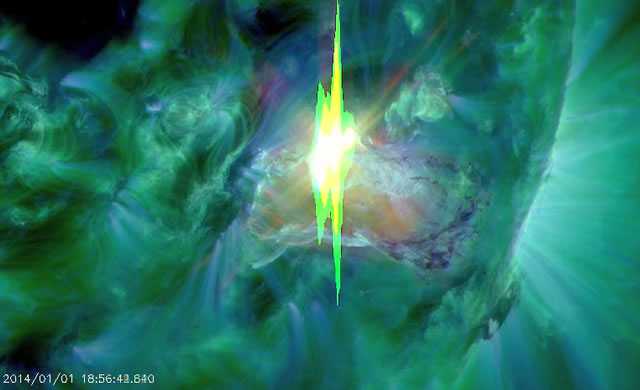
Credit: SDO
Il 2014 è iniziato con un botto. Alle 18:54 UT del 1 ° gennaio, la grande macchia solare AR1936 è esplosa, producendo un forte brillamento solare di classe M9. Il Solar Dynamics Observatory della NASA ha ripreso l’estremo lampo ultravioletto dell’esplosione.
La ripresa mostra un filamento scuro di plasma elevarsi dal luogo dell’esplosione, ma la maggior parte del materiale sembra essere ricaduto sulla superficie stellare. Tuttavia, l’esplosione ha prodotto una CME che potrebbe colpire di striscio il campo magnetico terrestre entro questa settimana. Gli analisti del NOAA stanno ancora valutando questa possibilità. Il flare M9 di Capodanno è stato seguito a ruota da un secondo brillamento M6 nella stesse ore, entrambi originati dalla regione solare AR1936. L’evento di Capodanno ha prodotto un minore, lento CME che non dovrebbe disturbare il campo magnetico della Terra, se e quando dovesse arrivare. La regione AR1936 è attiva, ma la nuova AR1944 fra tutte le macchie solari sembra ancora più potente. La gigantesca regione attiva è emersa sul lembo sud-orientale del sole il 1 gennaio. A causa della sua posizione ancora troppo vicina al bordo, la complessità del campo magnetico di AR1944 è ancora sconosciuta. Le dimensioni della macchia solare, tuttavia, suggeriscono che è in grado di emettere potenti brillamenti. L’emergere di AR1944 combinata con l’attività in corso di AR1936 ha spinto le previsioni NOAA ad aumentare le probabilità di nuove eruzioni per il 2 gennaio, portando al 70% per brillamenti di classe M e 30% per quelli di classe X.
2014 began with a bang. At 18:54 UT on January 1st, big sunspot AR1936 erupted, producing a strong M9-class solar flare. NASA’s Solar Dynamics Observatory captured the explosion’s extreme ultraviolet flash.
The movie shows a dark filament of plasma racing away from the blast site, but most of the material fell back to the stellar surface. Nevertheless, the explosion did produce a CME that could deliver a glancing blow to Earth’s magnetic field later this week. NOAA analysts are still evaluating this possibility. The M9-flare of New Year’s Day followed close on the heels of an M6-flare on New Year’s Eve. Sunspot AR1936 produced both explosions. The New Year’s Eve event produced a minor, slow-moving CME that is not expected to disturb Earth’s magnetic field if and when it does arrive. Sunspot AR1936 is active, but new sunspot AR1944 looks even more potent. The behemoth active region emerged over the sun’s southeastern limb on Jan 1st. Because of foreshortening near the sun’s limb, the complexity of AR1944’s magnetic field is still unknown. The sheer size of the sunspot, however, suggests it is capable of strong flares. The emergence of AR1944 combined with the ongoing activity from AR1936 has prompted NOAA forecasters to raise the odds of eruptions on Jan. 2nd to 70% for M-flares and 30% for X-flares.
Source/Continue reading → SpaceWeather.com





















